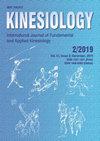SPEED-BASED HIGH-INTENSITY INTERVAL APPROACH AS AN ALTERNATIVE TO HEART RATE TRAINING: SIMILAR GAIN WITH LESS PAIN
IF 0.9
4区 医学
Q4 REHABILITATION
引用次数: 0
Abstract
The aims of this study were to: 1) compare the effects of speed-based versus heart-rate-based high-intensity interval training (HIT) on changes in high-intensity intermittent running performance, and 2) examine between-group differences in heart rate (HR) and rating of perceived exertion (RPE) responses during the training sessions. Sixteen female students were divided into the HR-based (n=8, M±SD, age 17.3±0.2 years, body mass, 59.2±5.7 kg, and body height, 167.8±2.2 cm) and speed-based (n=8, age 17.2±0.3 years, body mass, 57.7±6.4 kg, and body height, 171.0±5.1 cm) groups before commencing the HIT intervention. After completing five weeks of HIT, both the HR-based and speed-based groups showed most likely moderate enhancement in high-intensity intermittent running performance (+9%, 90% confidence limits [CL] [6.4; 11.7]; standardized change [ES] +1.04 [0.75; 1.33]) and (+9.2%, [6.0; 12.5]; +1.09 [0.73; 1.46]), respectively. However, the difference between the experimental groups with regards to changes in high-intensity running performance was trivial. Between-group differences of weekly average HR and RPE responses showed trivial to moderate (ES range; -0.95; 0.15) and moderate to very large (ES: -0.63; -2.88) values, respectively. Although it seems that both the speed-based and HR-based HIT approaches have some limitations when implementing for HIT individualization, using the speed reached at the end of the 30-15 Intermittent Fitness test (VIFT) seems to elicit the same performance enhancement, but with lower psychophysiological responses during short-term interventions. Key words: rating of perceived exertion (RPE), 30-15 Intermittent Fitness Test (30-15IFT), VIFT, physiological response, high-intensity running performance, young women基于速度的高强度间歇训练法作为心率训练的替代方法:疼痛减轻,效果相似
本研究的目的是:1)比较基于速度和基于心率的高强度间歇训练(HIT)对高强度间歇跑步性能变化的影响,2)检查训练期间心率(HR)和感知运动(RPE)反应评级的组间差异。16名女学生在开始HIT干预前被分为以hr为基础(n=8, M±SD,年龄17.3±0.2岁,体重59.2±5.7 kg,身高167.8±2.2 cm)和以速度为基础(n=8,年龄17.2±0.3岁,体重57.7±6.4 kg,身高171.0±5.1 cm)组。在完成5周的HIT训练后,HR-based组和速度-based组在高强度间歇跑步表现上都显示出最有可能的中度增强(+9%,90%置信限[CL];11.7);标准化变化[ES] +1.04 [0.75];1.33])和(+9.2%,[6.0;12.5);+ 1.09 (0.73;分别1.46])。然而,实验组之间在高强度跑步表现方面的差异微不足道。周平均HR和RPE反应的组间差异为轻微至中度(ES范围;-0.95;0.15)和中等到非常大(ES: -0.63;-2.88)值。虽然在实施HIT个性化时,基于速度和基于人力的HIT方法似乎都有一些局限性,但使用30-15间歇体能测试(VIFT)结束时达到的速度似乎可以引起相同的表现增强,但在短期干预期间,心理生理反应较低。关键词:感觉运动评分(RPE), 30-15间歇体能测试(30-15IFT), VIFT,生理反应,高强度跑步表现,年轻女性
本文章由计算机程序翻译,如有差异,请以英文原文为准。
求助全文
约1分钟内获得全文
求助全文
来源期刊

Kinesiology
REHABILITATION-SPORT SCIENCES
CiteScore
1.90
自引率
8.30%
发文量
16
审稿时长
>12 weeks
期刊介绍:
Kinesiology – International Journal of Fundamental and Applied Kinesiology (print ISSN 1331- 1441, online ISSN 1848-638X) publishes twice a year scientific papers and other written material from kinesiology (a scientific discipline which investigates art and science of human movement; in the meaning and scope close to the idiom “sport sciences”) and other adjacent human sciences focused on sport and exercise, primarily from anthropology (biological and cultural alike), medicine, sociology, psychology, natural sciences and mathematics applied to sport in its broadest sense, history, and others. Contributions of high scientific interest, including also results of theoretical analyses and their practical application in physical education, sport, physical recreation and kinesitherapy, are accepted for publication. The following sections define the scope of the journal: Sport and sports activities, Physical education, Recreation/leisure, Kinesiological anthropology, Training methods, Biology of sport and exercise, Sports medicine and physiology of sport, Biomechanics, History of sport and Book reviews with news.
 求助内容:
求助内容: 应助结果提醒方式:
应助结果提醒方式:


